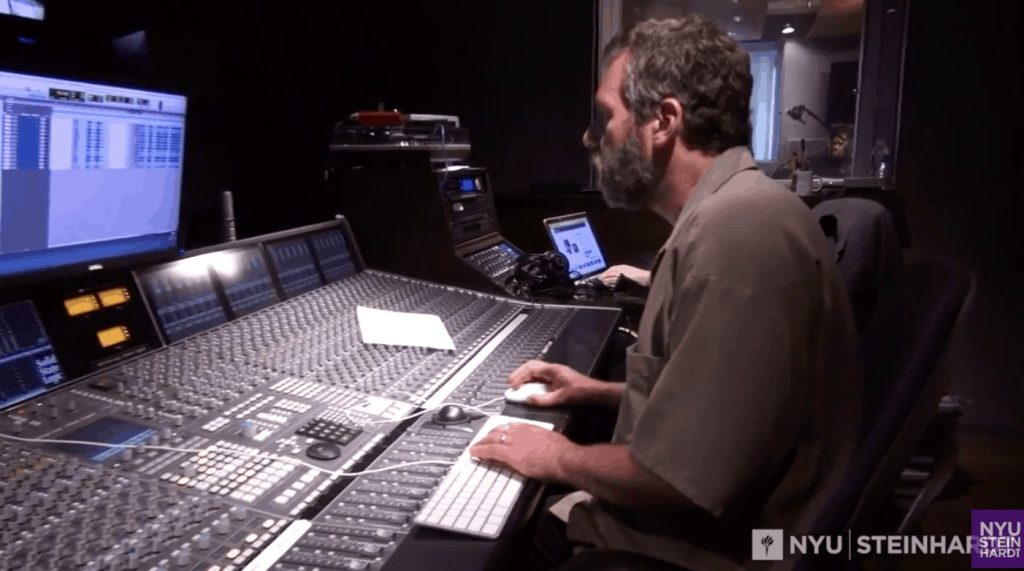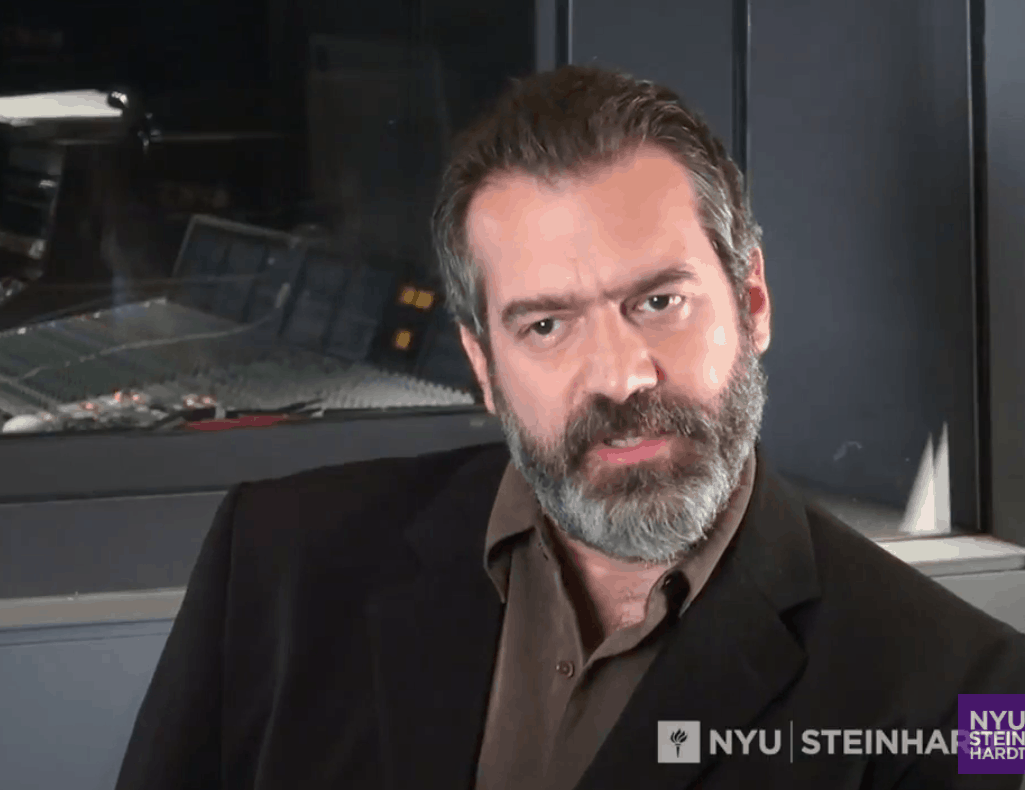We spoke with Paul Geluso to hear his thoughts on teaching, experiences with developing technology, and visions for expanding the music industry. With a varied and impressive portfolio, including serving as chief sound engineer at Harvestworks Digital Media Arts, teaching at Bard College, the Peabody Conservatory at John Hopkins, and of course currently at NYU, Mr. Geluso has also worked on countless music and film projects, including Grammy- and Latin Grammy-nominated titles. Read on to learn more about the promise of binaural development, the growth of consumer-friendly equipment, and more.
How would you describe your work? Do you feel it's mostly scientific, artistic or a balance of both?
A balance of both; I see myself as an engineer, musician, educator, and artistic collaborator. I primarily work with students and artists who work with sound in creative ways. My work is to facilitate and suggest technology to help see their creative vision through. For example, assisting a composer, sound artist, musician or a filmmaker with a new work. I also have introduced many people to immersive sound that have no or little previous experience with it. I have my own creative practice as an active musician, author, and sound designer too.
Who are some artists and/or engineers who have shaped your work?
Wieslaw Woszczyk at McGill University, who started their Tonmeister program, first introduced me to immersive sound. He has inspired many people with his teaching, research, and forward thinking for 3D audio. He brought a set of ribbon height speakers with him that we added to our 2D surround system at NYU in the early nineties bringing us into the 3D sound world as we started our own Tonmeister courses. Around that time I started working with former Deutsche Grammophon Tonmeister Gregor Zielinsky too; he was at Sennheiser then advocating for 3D audio and also introduced me to the amazing Wilfried Van Baelen at Auro-3D and fellow 3D sound pioneer Tom Ammerman at New Audio Technology GmbH. A little later, David Bowles, Grammy award winning engineer from Swineshead Productions, joined the NYU Tonmeister program guest faculty as well who also had great influence on how I record now. Working with students at NYU, Wieslaw, Gregor, David, and I have developed several microphone techniques to capture musical performances in 3D over the years. We made very high quality 3D recordings early on to present at AES conventions to let people experience it and share knowledge about how to capture high quality immersive sound. With her breadth of research, applications and future vision for 3D audio, Agnieszka Roginska more recently introduced me to binaural audio technology. There is a rapidly growing number of people working in Immersive doing amazing work now that inspires me as well.
You’ve worked across a variety of project types; what are some of the differences in producing for a movie versus an album versus an art exhibit?
An art exhibit is usually site specific. It's designed for one space and a single artistic vision. In those cases I will usually recommend and design a custom speaker system. For example, I designed multi-channel systems, 4 to 24 channels usually, for the Crystal Palace in Madrid, the Winter Garden and the Amory in NYC and at other public art spaces, including outdoors. For cinema, I work in more standard 5.1 or 7.1 environments with 2-6 height channels. For music it's the same, although we usually have a listening party at the time of release so fans can hear the work in immersive. I am working in Dolby ATMOS now and use Ambisonic formats as well usually mixing in an Auro-3D compatible 9.1 control room with the addition of ceiling mounted speakers for ATMOS compatibility. I am looking forward to working with MPEG-H tools next.
Disseminating popular music in 3D is a tough one - there's a countless number of consumers with unique listening environments. The most democratic way to go about distribution is through binaural audio, because most everybody has a set of headphones. I'm very excited about binaural audio with head tracking because it's very convincing. With static headphone monitoring, when you turn your head, the sound moves with your head, but in real life as you turn your head, your perception of sounds around you changes. So the combination of headphones, which gives us access to 3D audio, and dynamic head tracking, which gives us access to more natural interaction with sound, is very powerful. I'm pushing for that to be the new standard in the music industry.

A continuous project of yours is teaching. What would you tell engineering students to get them more involved in immersive audio in their careers?
I encourage working in 3D fully, and we have immersive labs and 3D sound equipment at NYU to support student projects and research. Auro-3D has always had a great system and currently Ambisonic, Dolby Atmos, and MPEG-H standards are making their way to internet and digital broadcast, theaters, and consumer products including home theater and gaming systems. Record companies and streaming services are now getting onboard with 3D as well. Students need to be prepared and experienced working in immersive. I feel like they should be working in binaural at least because it can do so much with just a set of headphones. For those lucky enough to study and work where they have surround sound plus high channels, I would say to take full advantage of them while you can. If your school doesn't have the facility, binaural is a great way to start and it might be good to ask to set up a 3D speaker mixing environment by augmenting a stereo or surround room, even if you have to mix and match speakers- we all started out that way.
5.1 surround sound systems never quite took off in my opinion, because the consumer didn't really go crazy for it. Stereo sounds great and surround wasn't that much better for many – enough to make the investment anyway. But with 3D most agree that this is something new and amazing. 2D surround sound had some issues because you had sound behind you, but not above you: there wasn't any glue between the front and the rear image. But with the high channels, the front and the back are bridged and you get a really fantastic fully immersive experience. I was never super excited about surround sound, but I got very excited about surround with height...I take that back. I actually loved quad, still love quad, but with the high channels, it's a different game and really fantastic.
In any case, immersive sound is finding its way finally and students in all areas of sound need to be prepared.
Is there a particular challenge in the field scholars and students should be focusing on?
Yes - getting 3D tools into the hands of creatives and to the consumer is challenging. We've had the means in our laboratories for years. People in academia have been working with multi-channel audio since the 60s and 70’s. A lot of work has been done in immersive, it's nothing new to those in education, but getting easy to use tools out to the creatives and 3D sound to the consumer is slow going. The gaming community is perhaps the exception because they appreciate and go for immersive environments and interaction. For the music industry, it's a tougher sell to get something rolled out to take the place of stereo, but we believe that with immersion sound, it’s worth it. For content creators, speakers are cheaper now; we have digital amps, we have lightweight speakers, we have audio interfaces with many outputs, so it's becoming exponentially cheaper to set up a multichannel system in a studio environment. And remember that you can get into it with just headphones with binaural synthesis technology. The cost is slowly getting out of the way. We’re at a great time where it's more realistic and accessible.
In your opinion, what is one of the most exciting recent or upcoming developments in audio technology bringing us closer to that?
I think the binaural technology's getting better and better. Also, I think the tools available for people working with sound in the Unity game engine mean people can build incredible interactive and immersive experiences. These tools are fantastic and most people with some programming experience, even beginners, can get their hands on them; there’s a lot of open source resources. Also, now we have compact speakers and amps that sound very good. For example, the Bose, Sony, JBL, and Sonos bricks allow people to have good sound that they can even carry around. Who dreamt you could get that amazing sound quality out of something so small? I am looking forward to the next generation 3D versions.
It’s exciting to keep watching as the innovations come forward. What is your next dream venture?
My next dream venture...It's to create streamlined head tracking, headphone-based audio tools for producers and distributors of music. Currently, I'm working with a wonderful immersive music artist Ozark Henry on this. We're working actively on a system that facilitates head tracking with binaural audio. We're taking advantage of the creative possibilities through composing directly for 3D audio over headphones with head tracking - it's very promising. I'm very excited about the head tracking headphones scenario, because it's a way that we can bring high quality immersive sound without people having to put speakers on the ceilings at home and so on. I think that commercial theaters and live venues should support 3D sound – but we can't expect the consumer to have that at home; it would make it an economic situation where only those who can afford such a room can enjoy it. I definitely want it to be more democratic than that.

That would definitely be great. To conclude, is there an album you would most like to hear in immersive audio format?
Oh - this is a really tough question. Hmm, for starters - I would like to hear the artists or similar artists on a label like the one Brainfeeder founded - Flying Lotus and crew, working in Immersive. I think electro-acoustic for fully electronic music, that kind of sound, would be wonderful to experiment with in immersive because it's otherworldly.
